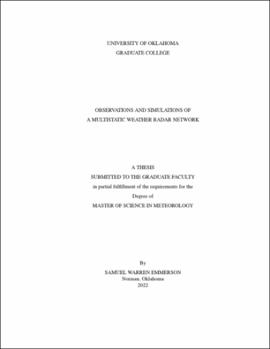| dc.contributor.advisor | Palmer, Robert | |
| dc.contributor.author | Emmerson, Samuel | |
| dc.date.accessioned | 2022-05-06T14:50:00Z | |
| dc.date.available | 2022-05-06T14:50:00Z | |
| dc.date.issued | 2022-05 | |
| dc.identifier.uri | https://hdl.handle.net/11244/335560 | |
| dc.description.abstract | Multistatic radar architectures have the potential to provide a cost-effective source of 3D wind information from both operational and research radars, owing to a system design of one transmitter and several receivers. A prototype multistatic network consisting of two passive receivers and the KTLX WSR-88D has been constructed in the Oklahoma City metropolitan area. To achieve sufficiently precise Doppler frequency estimates while reducing cost, transmitter/receiver synchronization is done through measurements of the WSR-88D’s sidelobe radiation, rather than an expensive GPS-based system. This yields an exceptionally simple system capable of producing bistatic moment data with virtually no cooperation from the transmitting radar system.
However, the main factor inhibiting the usage of such systems in 3D dual-Doppler wind retrievals is sidelobe contamination arising from the use of low-gain antennae with broad receive beams. Therefore, mitigation of sidelobe contamination should be paramount for those seeking to use this type of radar system. To this end, simulations of multistatic radar systems with varying receiver network layouts and transmitting techniques are performed to evaluate several strategies for reducing the effects of sidelobe contamination. One such strategy is to simply increase the number of receivers, which is shown to improve retrieval quality, albeit with diminishing returns. Another strategy is sidelobe whitening, which uses varying sidelobe phases to greatly reduce the coherent signal from the sidelobes. This technique alone is shown to markedly improve measured Doppler velocities and subsequent retrievals, especially in simulations of convective systems. Since sidelobe whitening can only be done with a phased array weather radar, the potential associated with a phased array-bistatic radar system is tremendous, particularly when coupled with the rapid-scan capabilities intrinsic to phased array systems.
Since the initial deployment of the prototype multistatic system, several datasets of severe convection have been collected, including several instances of quasi-linear convective systems (QLCSs) and supercells. Multi-Doppler retrievals done with the multistatic data are able to resolve important structures in the horizontal and vertical wind fields, including mesocyclones and horizontal rotors. These retrievals are shown to be comparable in accuracy to simultaneous multi-Doppler retrievals done with only monostatic radar data, though the deleterious effects of sidelobe contamination are apparent in the multistatic retrievals in some cases. | en_US |
| dc.language | en_US | en_US |
| dc.rights | Attribution-NonCommercial 4.0 International | * |
| dc.rights.uri | https://creativecommons.org/licenses/by-nc/4.0/ | * |
| dc.subject | Weather Radar | en_US |
| dc.subject | Bistatic Radar | en_US |
| dc.subject | Phased Array Radar | en_US |
| dc.title | Observations and Simulations of a Multistatic Weather Radar Network | en_US |
| dc.contributor.committeeMember | Bodine, David | |
| dc.contributor.committeeMember | Skinner, Patrick | |
| dc.contributor.committeeMember | Bluestein, Howard | |
| dc.date.manuscript | 2022-05 | |
| dc.thesis.degree | Master of Science in Meteorology | en_US |
| ou.group | College of Atmospheric and Geographic Sciences::School of Meteorology | en_US |
| shareok.orcid | 0000-0002-8106-0800 | en_US |

